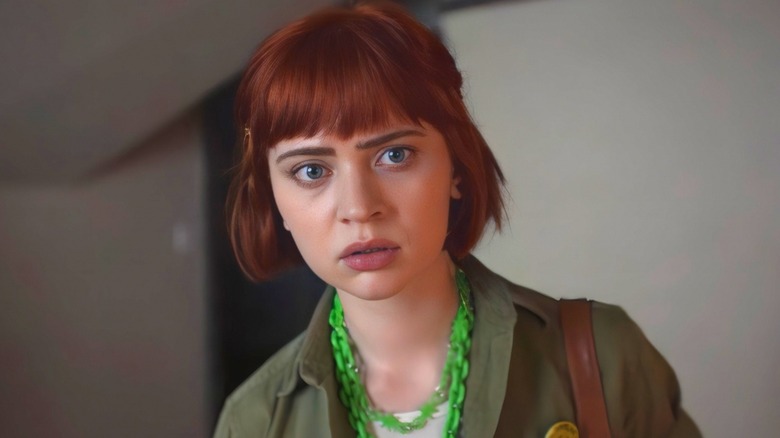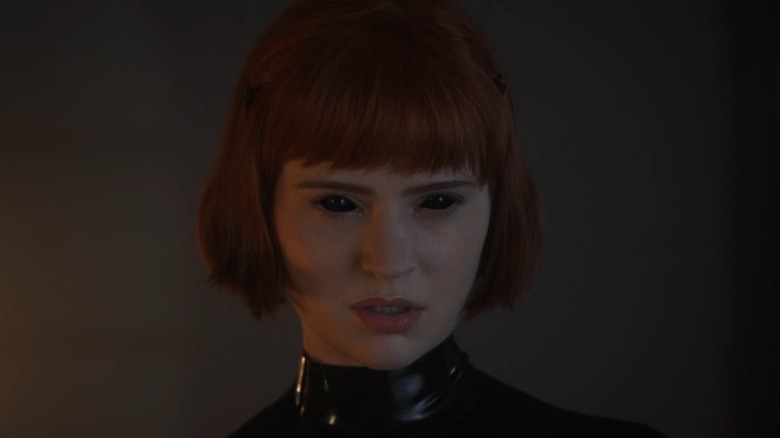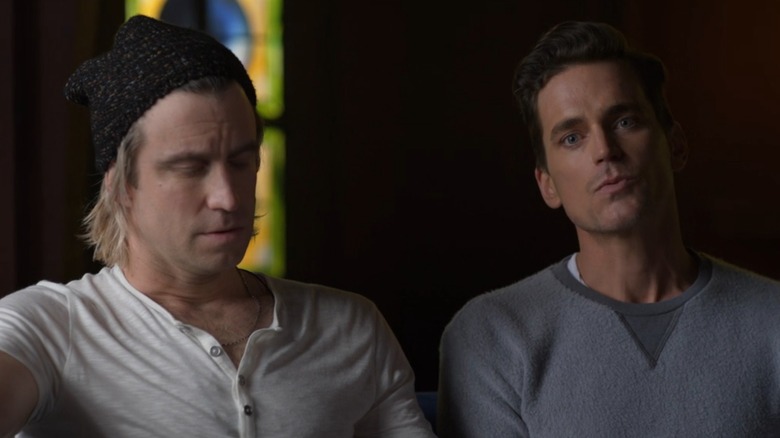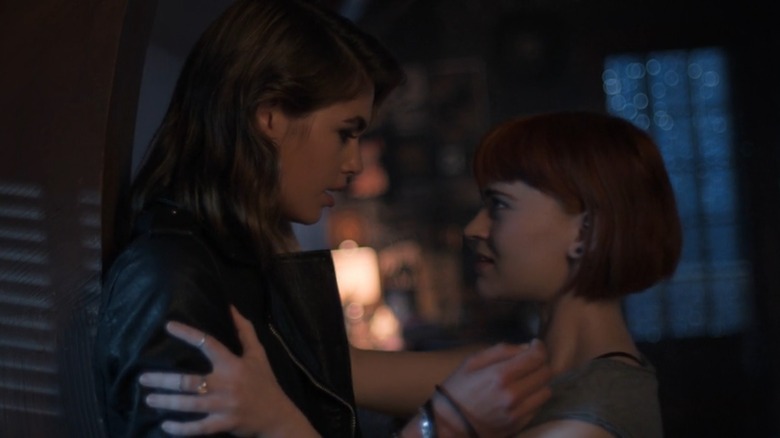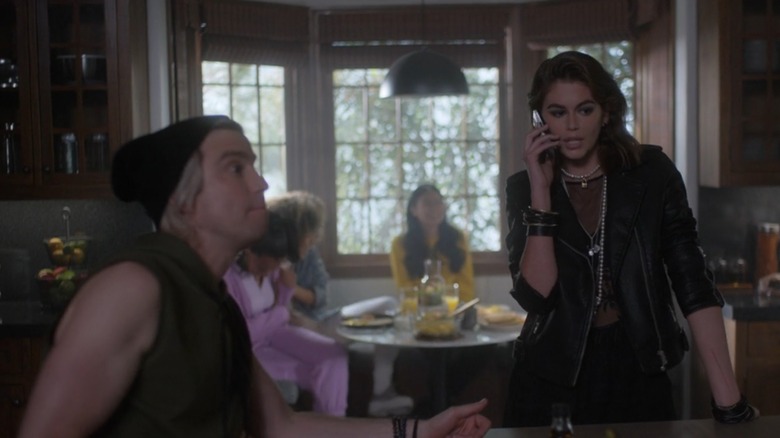American Horror Stories Rubber (Wo)man: Part Two Ending Explained
"American Horror Stories" kicked off its inaugural season by going back to where it all began. The first installment of this series of one-off tales is titled "Rubber (Wo)man: Parts One & Two" and just like the very first season of parent series "American Horror Story," it is set in Los Angeles' famed Murder House.
In part one, we're introduced to Michael (Matt Bomer), Troy (Gavin Creel), and their teenage daughter, Scarlett (Sierra McCormick). The family is moving into the notorious Murder House so that Michael and Troy can open a bed and breakfast catering to guests interested in the home's infamous history. Despite the reputation, Michael and Troy are skeptics who don't believe the stories of supernatural evil that have plagued the house for a century. However, they'll soon learn firsthand that sometimes even the most outlandish urban legends have some basis in truth.
Scarlett, meanwhile, begins her own journey into darkness when she discovers Tate Langdon's (Evan Peters) infamous rubber suit in one of the house's closets. After trying it on once, she's startled by the innate power of the garment. But when the suit reappears after she's attempted to throw it away, she gives in and sees what life is like behind the black rubber hood.
As the central piece of fetish gear suggests, "Rubber (Wo)man" is ultimately a story about intimacy and control.
The rubber suit itself plays a critical role on Rubber (Wo)man
Midway through the first part of "Rubber (Wo)man," we learn that Scarlett isn't merely a stylish and moody teenager. She's confronted by Michael and Troy for looking at extremely violent S&M pornography that they believe goes beyond the normal bounds of sexual curiosity.
If Scarlett was flirting with an unsettling amount of darkness before moving to the Murder House, those interests get amplified to an extreme degree when she begins putting on the rubber suit. The second time she wears it, there's a shot of her eyes turning completely black, implying that the suit is having some kind of supernatural effect on her. By the end of part two, Scarlett has committed countless murders — most notably the slaying of a group of mean girls who tormented her — while wearing the suit.
This begs the question: Was Scarlett always destined to become a sadistic serial killer, or did she fall under the demonic influence of the suit itself? As with many things in the "American Horror Story" universe, the answer most likely lies somewhere in between.
Early in part one, Scarlett is in a human anatomy class having a discussion about the parts of the brain that cause our fear response. She offers her own theory: "Shame [not fear] is what keeps us from being our true selves." Given its association with the ghosts of "Murder House," it's clear that the rubber suit itself has a supernatural element. But it also has a very standard practical one, as well. It covers Scarlett's face and body and enables her to live out her violent fantasies anonymously without shame.
Maybe she would have gone on to live a normal life had she never encountered it, but it's clear that even before the rubber suit came into her life, Scarlett had an innate attraction to sadism.
Michael and Troy ultimately find happiness in death
While Scarlett is at the center of "Leather (Wo)man," her fathers also play an important role not just in the action of the narrative, but also in the themes of the story. For as much as they admonish their daughter for her predilection toward sadism, in part two, we come to learn that Michael and Troy have their own issues in that area.
Things get tricky for the couple when Troy tries to hire an attractive contractor named Adam (Aaron Tveit) in an attempt to get them out of the financial pit remodeling the Murder House has put them in. Michael is not only unhappy that Troy went behind his back to make a business decision, but he also immediately recognizes that Adam was not hired merely because he's offering a good rate.
"You're cruel ... you kinda get off on hurting people," Michael tells his husband. "It's subtle, like the joy you take in not returning a phone call or being the first to tell someone that their partner is cheating ... it's so subtle, Troy. It just looks like a little bit of naughty fun. But I know it's more than that to you." In an episode that includes many physical acts of sadism, we also see Troy performing some emotional ones.
Michael and Troy do end the story in a better place, but it's not until after they are murdered by Scarlett's new girlfriend (more on her in a second) that they find bliss. Being dead releases them from the stress of earthly responsibilities such as money and allows them to rediscover why they fell in love in the first place.
Ruby learns that controlling Scarlett isn't the path to a successful relationship
Michael and Troy aren't the only couple navigating a complicated relationship dynamic. In part two, Scarlett begins dating Ruby (Kaia Gerber), the ghost of a young woman with a deeply troubled past who is tethered to the Murder House. Like Scarlett, she is a sadist who loves the control that inflicting pain on others gives her. But they quickly find trouble in their violent paradise.
Ruby wants to kill Scarlett so that she'll also be tethered to the house forever. Scarlett, on the other hand, isn't so sure that she's ready to give up the freedoms that living in the real world provides. As with most relationship issues, it's a conflict that requires compromise. Scarlett makes it clear that she intends to leave the house and while Ruby would prefer to have her girlfriend by her side at all times, she grants her that wish. The classic "American Horror Story" ghost loophole — that Halloween serves as the one day a year when spirits can roam free — allows the couple some leeway to make their long-distance/cross-state of being relationship work.
The episode ends with a voiceover from Ruby that describes how difficult, but ultimately rewarding, finding the right balance of control in a relationship is. She calls happiness "something to look forward to" and goes on to describe how blissful it is when Scarlett returns to her for that one night a year.
The waiting is hard, but it's part of being in a healthy relationship. Ruby's abandonment issues make it difficult to trust that Scarlett will return if she's allowed to leave. However, she also knows that controlling Scarlett like one of her victims would be disastrous to their union.
What Rubber (Wo)man and Murder House have in common
As far as connections to the rest of "American Horror Story" are concerned, the narrative of "Rubber (Wo)man" mostly stands alone. There are plenty of small references to "Murder House," including very brief cameos by Tate, Piggy Man, and the grotesque Infantata, but these mostly serve as fun Easter eggs rather than significant tie-ins. However, the stories told in "Rubber (Wo)man" and "Murder House" do share many elements in common.
Beyond the archetype of a haunted house steeped in urban legend, "Murder House" is also the "American Horror Story" season that is most firmly rooted in modern domesticity and family. Much of the plot of that season revolved around the intimate dramas of the Harmon family and many of the manifestations of horror were directly related.
"Rubber (Wo)man" is also family-centric and weaves together themes such as the fallout from infidelity and conflicts caused by financial troubles. Not all of these comparisons line up one-for-one, but it does feel that in returning to the Murder House, Ryan Murphy and Brad Falchuk were also revisiting some of the same ideas.
Both narratives also conclude in a similar place. Despite the nightmares they face, the Harmon family ends "Murder House" gathered around the Christmas tree as a ghostly family. "Rubber (Wo)man" also has a remarkably happy ending given its otherwise grim story. Not only have Scarlett and Ruby found a way to make their relationship work, but Michael, Troy, and even the mean girls from Scarlett's school are all living together as ghosts in domestic bliss.
It all goes to show that even though some of them contain horrors, home really is where the heart is.
